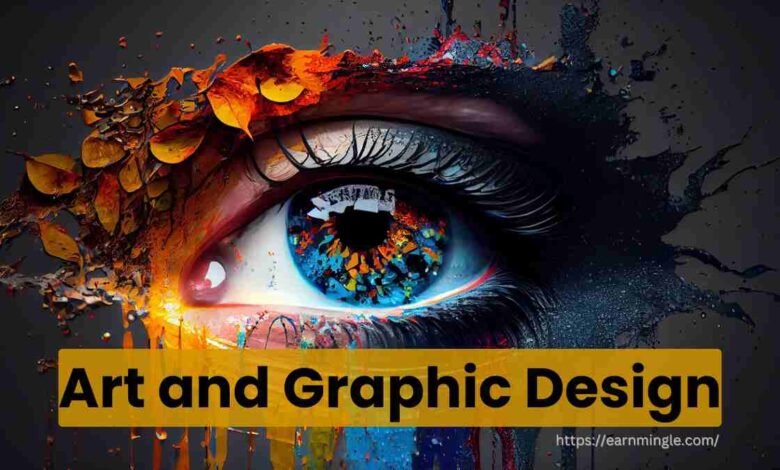Art and Graphic Design: Perfect Fusion of Creativity & Technology

Art and graphic design represent two different fields that, however, share some intrinsic relationship. Art has been an important part of human culture since centuries as a form of expression, communication, and innovation.
The Evolution of Art
The Historical Development of Art
This even started in prehistoric times and began with early man paintings on cave walls.
Those early arts did not just service to simply present beauty, but a way of expression and communication. Art itself was a bit complicated when human beings evolved. Indeed, from times like those early periods towards the grand frescoes during the Renaissance, art itself seemed to mirror what happens with time and period itself.
Traditional Art Forms and Techniques
Traditional art includes painting, sculpture, drawing, and printmaking. Each medium has its techniques and materials: oil paints, charcoal, clay, and etching plates, to name a few. Mastering them takes years and excellent comprehension of the material used. During all these years, artists continued to experiment with styles and approaches that would shape the following generations.
The Impact of Technology on Art
The digital tools and the platforms have opened up possibilities that, at one time, artists could hardly think of. For example, the very concept of digital painting, 3D modelling, and virtual reality art has radically changed the entire concept of art practice. But despite all these developments, the very core and the fundamental principles of art-the creativity, expression, and communication-remain exactly the same.
Follow Us: Earn Mingle
Graphic Design: A New Age of Creativity
The Birth of Graphic Design
It emerged as a discipline in the early 20th century with the onset of advertising and mass communication, bringing together aspects of art, typography, and layout to create visual content. The Bauhaus movement also played a great role in shaping and emphasizing functionality, simplicity, and the integration of technology.
Main principles of graphic design
These principles assist designers in the making of more appealing and successful designs. A successful graphic design is that which grabs the attention of the reader but at the same time, the message can be communicated with fewer words. Knowledge of these principles is fundamental for any aspiring graphic designer.
The Role of Graphic Designers
Graphical design is the creation of visible graphics material. Through advertisements, websites, logos, or even packaging, an idea could be communicated to the market, and graphic designers are supposed to do all this work. The eye for details, understanding the principles of design, and experience of using several software packages by the graphic designer are imperative. Graphic designers are meant to create not only gorgeous visual content but also problems solving to cater to clients and audiences.
The Interconnection Between Art and Graphic Design
How Art Affects Graphic Design
Art has always had such a great influence. Many graphic designers draw from the old art forms, in color, composition, and texture, to create. The lines are blurred, and many projects are born of both disciplines.
The Artistic Elements of Graphic Design
Art inherently refers to the core of graphic designing by way of color theory, composition and visual storytelling, which basically identify the three elements that articulate art itself. Graphic designing will likely use more forms of art in their practices such as collage, hand lettering, and illustrative designs to give each design personality. This merger of art and design results in rich imagery and compelling emotions for content.
The Use of Traditional Art Techniques in Modern Graphic Design
Most designers in some way still find a part of their designs rooted in ancient times despite the strong dependency on these digital tools. Texture in any given watercolor painting, as well as pencil sketching with all hand-drawn elements can be scanned into this digital playground. This makes the product absolutely unique, hence made special, from its counterparts amidst this digitally-driven landscape.
The Tools of the Trade
Traditional Art Tools and Materials
Artworks throughout time have always had to deal with implements and materials that came into use-brush and paint, to chisel and stone, each with properties and, in turn, specific methods in their application. Though nothing can equal the opulence and richness of oil paint, charcoal is wonderful for gestural drawings and all the more so without flaws. It is quite simple, therefore, where one set of tools or material will lead to an end result of the finished work of art.
Modern Graphic Design Software and Tools
However, graphical artists use a variety of technologies because there mainly is a computer-based version. This includes Photoshop from Adobe. Illustrator is another. Such programs give designers the capacity for extreme degrees of flexibility in designing and editing and altering at exact easiness. Again, by democratizing its nature of availability, it levelled this game with more people pursuing through such without the help of tradition skills.
Creative Process
The Artistic Process: From Concept to Creation
Art creative process usually begins from an idea or concept. Normally, starting with a rough sketch or even studies, because artists play around with lots of composition, color, or technique during this exploratory phase, which is when the art will be created: sometimes, in multiple layers and steps with revisions. Often intuitive, the outcome is just following the artist’s personal vision and emotions that are pouring through.
Effects on society through art and graphic design
Art is The Mirror of Society.
Art always mirrors the society it belonged in. It describes, minute-by-minute, the value and beliefs of human life experience. From the heyday of the Renaissance down to abstractionism, modernity led art forms created based on the cultural, political, and social contexts of its respective era. Art sparks the thoughts inside one’s mind, moves hearts, and even gives ways for change; hence, art can be one important mover in our world.
Graphic Design as a Tool of Communication
Graphic design, however, is fundamentally for communication. It carries its messages, information, or ideas in a graphic presentation. Graphic design plays such an important role in daily life: there are road signs and posts for social media. It allows people to understand complex information by taking the complicated idea of any theme and conveying it in simple and effective graphical form.
Both Impact Culture and Trends.
Both have a lot to contribute to the creation of culture and trends. In many ways, art movements have taken the lead in design trends and vice versa. While Bauhaus minimalism inspired generations, modern trends in design are drawing from street art and pop culture. This dialectical relationship between art and design continues to define visual culture in our times.
The Future of Art and Graphic Design
Emerging Trends in Art
Of course, the art world is dynamic and continually transforms: new trends and new styles are appearing frequently, all of which is inspiring further creativity in artists through areas as street and digital art, among immersive experience.
Conclusion
The art and design are two sides of a constantly changing relationship with the help of creativity, expression, and communication. As innovation goes on, the distinction between the two will decrease, and thus inventing a new world privilege for the inventors. It is not just an overflow of talent and ideas for artists and designers, but the entire road indeed becomes brighter with endless possibilities.
Read More: Arbitrage Trading in Crypto





